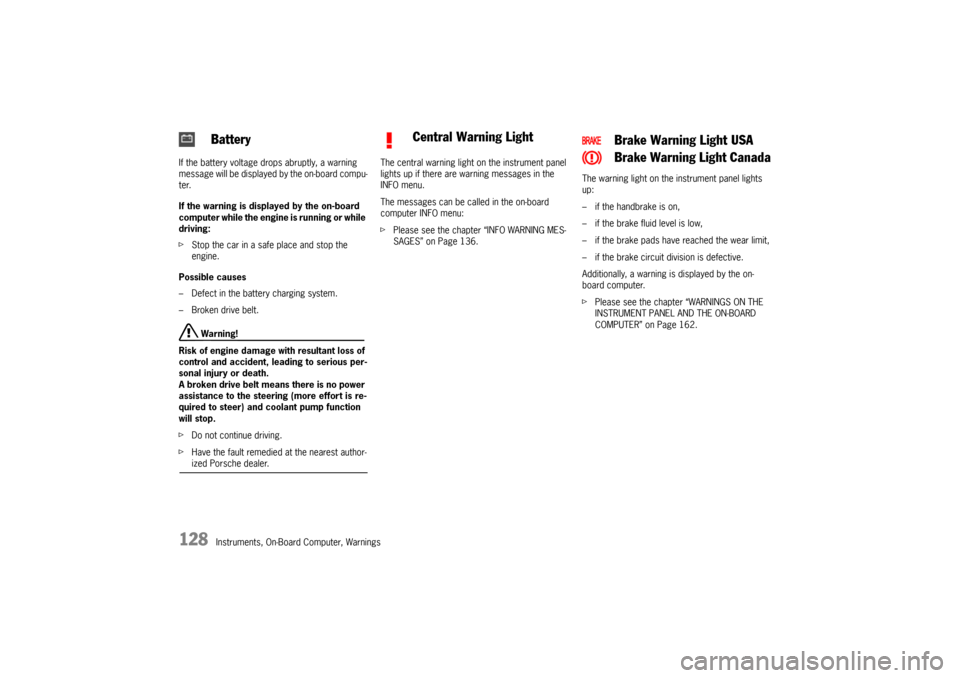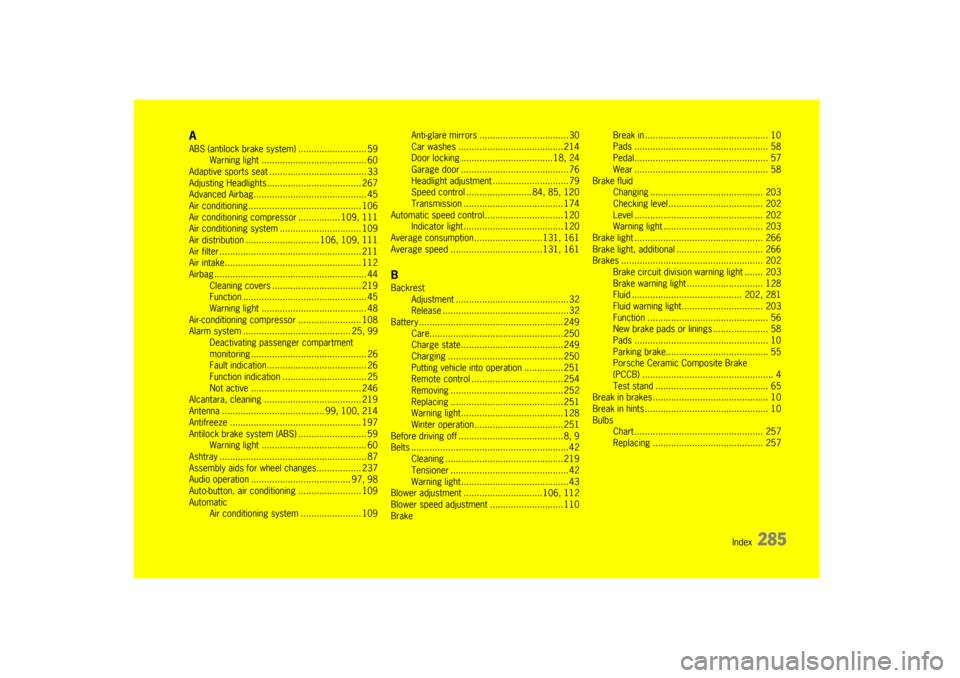2010 PORSCHE BOXSTER S charging
[x] Cancel search: chargingPage 19 of 294

Operation, Safety
17
Malfunction of the remote controlThe remote control may not function correctly due
to local radio wave interference. The vehicle will
then not lock properly.
This can be identified by the missing locking
sound and the missing check-back signal of the
emergency flasher.
If this should occur:
f Lock the vehicle with the key in the door.
The remote-control standby function
switches off after 7 daysIf the vehicle is not started or unlocked with the re-
mote control within 7 days, the remote control
standby function is switched off (to prevent dis-
charging of the vehicle battery).
1. In this case, unlock the driver’s door with the
key at the door lock.
Leave the door closed in order to prevent the
alarm system from being triggered.
2. Press button 1 on the remote control.
The remote control is now activated again and
the alarm system is switched off.
Operational readiness of the remote
control interruptedEncoded data is transmitted to the vehicle each
time the wireless remote control is operated. If the
remote control is operated too often outside the
range of the vehicle, this can result in the central
locking system no longer responding.
In this case, the remote control and vehicle must
be synchronized.
Carrying out the synchronization
1. Unlock the driver's door with the key at the door lock.
2. Open driver’s door and insert the ignition key into the ignition lock within 10 seconds to
prevent the alarm system from being
triggered.
3. With the key inserted, press and hold button 1
on the remote control for approx. 5 seconds.
The synchronization is now complete.
Page 75 of 294

Operation, Safety
73
Switch position 2Start engine
fTurn ignition key to ignition lock position 2 .
f Please see the chapter “STARTING PROCEDU-
RES” on Page 75.Switch position 3Ignition off
fTurn ignition key to ignition lock position 3 .
Note on operation
The vehicle battery discharges if the ignition key is
left inserted.
If the vehicle battery is dead, the key can only be
pulled out of the ignition lock if the emergency
operation is performed:
f Please see the chapter “EMERGENCY OPERA-
TION – PULLING OUT THE IGNITION KEY” on
Page 74.
Locking the steering columnAutomatic locking
The steering column is automatically locked when
the ignition key is withdrawn from the ignition lock.
Warning!
Risk of an accident, re sulting in serious per-
sonal injury or death.
The steering wheel will lock and will cause
loss of steering.
f Never remove key from the ignition lock or turn
the key off while the vehicle is moving.
f Always withdraw the ignition key when leaving the vehicle. Automatic unlocking
The steering column is unlocked when the vehicle
is unlocked with the radio remote control.
Note
f
To avoid discharging the battery, always re-
move the ignition key from the ignition lock.
Please see the chapter “BATTERY” on
Page 249.
Gong If you leave the key in the ignition/steering lock, a
gong will sound when the driver’s door is opened.
This is a reminder to remove the key.
Page 78 of 294

76
Operation, Safety
Stopping Engine fTurn key back to position 3.
f Do not stop engine immediately after hard or
extended driving.
Keep engine running at increased idle for
about two minutes to prevent excessive heat
build-up before turning off engine.
f To avoid discharging the battery, always re-
move the ignition key from the ignition lock.
f When leaving the car, always remove the igniti-
on key, apply the parking brake and engage
1st gear or reverse gear on vehicles with ma-
nual transmission or move the selector lever to
position P on vehicles with PDK transmission.
f Engage the steering lock by moving the steer-
ing wheel to the left or right.
Turn the steering wheel to the locking position
before you switch off the engine so that you
don’t have to exert your self when locking or
unlocking the steering.
Warning!
Danger of injury. Hot engine compartment
components can burn skin on contact.
f Before working on any part in the engine
compartment, turn the engine off and let it cool
down sufficiently. Risk of burn injury when standing near or
coming into contact with the exhaust pipe.
The exhaust pipe is hot wh
en the vehicle is running
and remains hot for some time after the vehicle is
turned off.
f To prevent injury, make a point of noting where
your vehicle’s exhaust pipe is, avoid placing
your legs near the exhaust pipe, and closely
supervise children around the vehicle when the
exhaust pipe could be hot.
A hot exhaust pipe can cause serious burns.
Engine-compartment blower,
radiator fan The radiator and radiator fans are in the front of
the car.
The engine-compartment bl ower is mounted in the
engine compartment.
Warning!
Risk of injury.
After the engine is switched off, the engine-
compartment temperature is monitored for
approx. 30 minutes.
During this period, and depending on tem-
perature, the engine-compartment blower
may continue to run or start to run.
f Carry out work in these areas only with the en-
gine off, the ignition off, and exercise extreme
caution. Risk of injury. The radiator fans in the front
end of the car may be operating or
unexpectedly start operating when the
engine is switched on.
f
Carry out work in these areas only with the en-
gine switched off.
Automatic garage door The ignition system in your Porsche may interfere
with your electronically operated garage door.
fTo check this, drive your Porsche close to the
garage door. Make sure not to interfere with
the operating range of the door.
f Run the engine at different speeds.
f If the garage door opens or closes without you
operating the garage door unit in your car,
contact the dealer who installed the automatic
garage door to have the frequency and/or
coding of the garage door signal changed or
modified.
Page 130 of 294

128
Instruments, On-Board Computer, Warnings
If the battery voltage drops abruptly, a warning
m e s s a g e w i l l b e d i s p l a y e d b y t h e o n - b o a rd c o m p u -
ter.
If the warning is displayed by the on-board
computer while the engine is running or while
driving:
f
Stop the car in a safe place and stop the
engine.
Possible causes
– Defect in the battery charging system.
– Broken drive belt.
Warning!
Risk of engine damage with resultant loss of
control and accident, leading to serious per-
sonal injury or death.
A broken drive belt means there is no power
assistance to the steering (more effort is re-
quired to steer) and coolant pump function
will stop.
f Do not continue driving.
f Have the fault remedied at the nearest author-ized Porsche dealer. The central warning light on the instrument panel
lights up if there are warning messages in the
INFO menu.
The messages can be called in the on-board
computer INFO menu:
f
Please see the chapter “INFO WARNING MES-
SAGES” on Page 136. The warning light on the instrument panel lights
up:
– if the handbrake is on,
– if the brake fluid level is low,
– if the brake pads have
reached the wear limit,
– if the brake circuit division is defective.
Additionally, a warning is displayed by the on-
board computer.
f Please see the chapter “WARNINGS ON THE
INSTRUMENT PANEL AND THE ON-BOARD
COMPUTER” on Page 162.
Battery
Central Warning Light
Brake Warning Light USA
Brake Warning Light Canada
Page 251 of 294

Practical Tips, Emergency Service
249
Battery The battery is located in the front luggage
compartment under a black plastic cover.
f Please see the chapter “EMERGENCY OPERA-
TION – PULLING OUT THE IGNITION KEY” on
Page 74.
f Please see the chapter “EMERGENCY UNLO-
CKING OF THE FRONT LUGGAGE COMPART-
MENT LID” on Page 248.
Warning!
Risk of short circuit, fire and damage to alternera-
tor and electronic control units, resulting in seri-
ous personal injury or death.
f Observe all warning notes on the battery.
f Disconnect the negative terminal on the bat-
tery during all work on the electrical system.
f Do not lay tools or other metal objects on the
battery as they could cause a short circuit
across the battery terminal.
Hydrogen gas generated by the battery
could cause an explosion, resulting in
serious personal injury or death.
f Do not expose the battery to an open flame,
electrical spark or a lit cigarette.
f Do not wipe battery with a dry cloth.
Risk of serious personal injury or death and
damage to the fabric, metal or paint. f
Wear eye protection.
f Do not allow battery acid to come in contact
with your skin, eyes, fabric or painted
surfaces.
f If you get electrolyte, which is an acid, in your
eyes or on your skin, immediately rinse with
cold water for several minutes and call a doc-
tor.
f Spilled electrolyte must be rinsed off at once
with a solution of baki ng soda and water to
neutralize the acid.
Battery posts, terminals and related acces-
sories contain lead and lead compounds,
chemicals known to the State of California to
cause cancer and reproductive harm.
f Always protect your skin by washing thorough-
ly with soap and water.
Risk of explosion as a result of static charge,
resulting in serious personal injury or death.
f Do not wipe the battery with a dry cloth.
f Eliminate potential electrostatic charge by
touching the vehicle before touching the bat-
tery.
Charge state A well-charged battery prevents starting problems
and has a longer service life.
Traffic density, requirements regarding noise, ex-
haust gas and fuel consumption reduce the engine
speed and, hence, the alternator output.
However, the large number of electrical loads has
markedly increased the demand for electrical po-
wer.
In order to avoid discharging the battery
unintentionally:
f Switch off unnecessary electrical loads in city
traffic, on short trips or in a line or traffic.
f Always remove the ignition key from the igni-
tion switch when leaving the car.
f Avoid frequent operation of the convertible top
and operation of the Porsche Communication
Management system and audio system when
the engine is not running.
f In the cold season in particular or if the vehicle
is used primarily for short journeys, it may be
necessary to recharge the battery from time to
time.
Page 252 of 294

250
Practical Tips, Emergency Service
Battery care fEnsure that battery is securely mounted.
f Keep terminals and connections clean and
properly tightened.
Corrosion can be prevented by coating the ter-
minals and connections with petroleum jelly or
silicone spray.
f Ensure that vent caps ar e securely tightened to
prevent spillage.
Checking the electrolyte fluid level
The acid level should be checked more frequently
by a qualified specialist workshop during the sum-
mer months and in predominantly warm countries. Battery charging
Automotive batteries lose their efficiency when
not in use.
The charge available in your battery can be meas-
ured with a battery hydrometer.
We recommend that the battery voltage be tested
by your authorized Porsche dealer who has the ap-
propriate equipment.
If the car is not driven for prolonged periods, the
battery must be charged at least every 6 weeks.
A discharged battery allows
rapid formation of sul-
fates, leading to premature deterioration of the
plates.
Warning!
Hydrogen gas generated by the battery
could cause an explosion, resulting in
serious personal injury or death.
f Charge battery in a well ventilated area.
f Never charge a frozen battery. It may explode
because of gas trapped in the ice. Allow a fro-
zen battery to thaw out first.
f If you get electrolyte, wh ich is an acid, in your
eyes or on your skin, immediately rinse with
cold water for several minutes and call a doc-tor. Slow battery charging
Your authorized Porsche dealer will be pleased to
advise you about a suitable charger.
1. Always observe the instructions of the charger
manufacturer.
Depending on the type of charger, the battery
may have to be disconnected.
In this case, always disconnect the negative
lead first, and then the positive lead – risk of
short circuit!
Reconnect the leads in reverse order.
2. Before charging, cold batteries must be warmed up indoors.
3. Frozen batteries must be thawed out first before being charged.
4. When charging, ensure that there is adequate ventilation.
5. Connect the charger to the battery. Only plug into the mains and switch the
charger on when it is connected up correctly.
6. Switch on the charger.
7. After charging, switch off the charger first and then disconnect it.
f Please see the chapter “PUTTING VEHICLE
INTO OPERATION” on Page 251.
Page 287 of 294

Index
285
AABS (antilock brake system) .......................... 59
Warning light .......... .............................. 60
Adaptive sports seat ..................................... 33
Adjusting Headlights.... ................................ 267
Advanced Airbag......... .................................. 45
Air conditioning ........... ................................ 106
Air conditioning compressor ................ 109, 111
Air conditioning system .................... ........... 109
Air distribution ................ ............ 106, 109, 111
Air filter ...................... ................................ 211
Air intake.................... ................................ 112
Airbag ............................ .............................. 44
Cleaning covers ...... ............................ 219
Function ..................... .......................... 45
Warning light .......... .............................. 48
Air-conditioning compressor ........................ 108
Alarm system ................. ........................ 25, 99
Deactivating passenger compartment
monitoring .............. .............................. 26
Fault indication........ .............................. 26
Function indication ................................ 25
Not active .............. ............................ 246
Alcantara, cleaning . .................................... 219
Antenna ................. ...................... 99, 100, 214
Antifreeze .................................................. 197
Antilock brake system (ABS) .......................... 59
Warning light .......... .............................. 60
Ashtray .......................... .............................. 87
Assembly aids for wheel changes................. 237
Audio operation ...................................... 97, 98
Auto-button, air conditioning ........................ 109
Automatic Air conditioning system ....................... 109 Anti-glare mirrors .......................
...........30
Car washes .............. ..........................214
Door locking ............. ......................18, 24
Garage door ......... ................................76
Headlight adjustment .............................79
Speed control .........................84, 85, 120
Transmission ............ ..........................174
Automatic speed contro l..............................120
Indicator light ........ ..............................120
Average consumption .... ......................131, 161
Average speed ............. ......................131, 161
BBackrest
Adjustment ............... ............................32
Release .................... ............................32
Battery ......................... ..............................249
Care......................... ..........................250
Charge state......... ..............................249
Charging .................. ..........................250
Putting vehicle into operation ...............251
Remote control ..... ..............................254
Removing ................. ..........................252
Replacing ................. ..........................251
Warning light......... ..............................128
Winter operation.... ..............................251
Before driving off ...... ..................................8, 9
Belts ................ ............................................42
Cleaning ................... ..........................219
Tensioner ................. ............................42
Warning light......... ................................43
Blower adjustment ........ ......................106, 112
Blower speed adjustme nt ............................110
Brake Break in ...................
............................ 10
Pads ....................... ............................ 58
Pedal....................... ............................ 57
Wear ....................... ............................ 58
Brake fluid
Changing ................. .......................... 203
Checking level ...... .............................. 202
Level ....................... .......................... 202
Warning light ............ .......................... 203
Brake light .............. ................................... 266
Brake light, addition al ................................. 266
Brakes ........................ .............................. 202
Brake circuit division warning light ....... 203
Brake warning light ............................. 128
Fluid ............................ .............. 202, 281
Fluid warning light. .............................. 203
Function .................. ............................ 56
New brake pads or linings ..................... 58
Pads ....................... ............................ 10
Parking brake....... ................................ 55
Porsche Ceramic Composite Brake
(PCCB) .................................... .............. 4
Test stand ........... ................................ 65
Break in brakes ....... ..................................... 10
Break in hints .......... ..................................... 10
Bulbs
Chart ....................... .......................... 257
Replacing ................ ..........................2
57